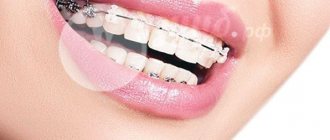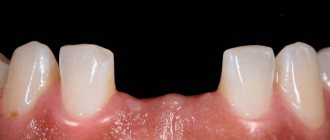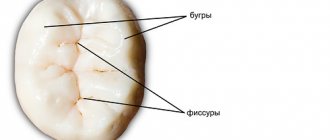In modern dentistry, there are many different methods for restoring damaged teeth - filling, prosthetics, installing inlays. The first two technologies are well known to patients, but few people know that teeth can be successfully restored with inlays.
What are tooth inlays, how do they differ from regular fillings, and in what cases is the use of inlays indicated? We will answer all these questions in detail in this article on our website.
Review of composite inlays - purpose in dentistry, pros and cons, alternatives
Article navigation
- What are these structures?
- Materials
- Indications
- Contraindications
- Advantages and disadvantages
- Stages
- Complications
- Life time
- Care
- Alternatives
- Price
Question for a specialist
Dental inlays made of composite synthetic materials are considered an affordable and easy-to-manufacture solution for restoring teeth.
But, at the same time, dentists rarely recommend their installation due to the large number of shortcomings of the material. Today we will talk about what a composite tab is, its pros and cons, in what situations it is used, and what alternatives there are.
Reviews
Most positive reviews relate to the use of inlays made of ceramic, titanium and gold.
Both practitioners and patients share the same opinion that composite materials are becoming obsolete. This is explained by the fragility of the product and the rapid loss of whiteness.
In addition, the initial savings on the product are accompanied by the need for repeated prosthetics.
You can leave your opinions and comments in this article.
If you find an error, please select a piece of text and press Ctrl+Enter.
Tags prosthetics tabs
Did you like the article? stay tuned
Previous article
When is it appropriate to use short dental implants?
Next article
In what cases does the gap between the crown and the gum require immediate treatment?
What are these structures and what are they?
Composite inlays for teeth – what are they? This is the name for microprostheses, the function of which is to restore a damaged tooth (due to injury or caries, including a secondary one under a filling). This includes two types of composite structures - these are composite and stump inlays, which are manufactured only by the indirect method in a laboratory. But more on this later, and now let’s take a closer look at the classification.
Restorative composite inlay
A restorative composite inlay restores minor damage to a tooth, most often on the chewing surface. At its core, restorative is a microprosthesis in the form of an overlay on the very top part of the crown or its side (wall). Also, a restoration tab can be called an analogue of a filling. Only an onlay made of a composite will last longer than a filling made of the same material. When worn for a long time, a regular filling begins to sag and peel off from the walls, and as a result, caries develops underneath it - a restorative composite inlay is more reliable in this regard.
Don't know what type of prosthetics to choose?
We will help in the selection, advise where to read more information and compare types of prosthetics.
Consultation with an orthopedic doctor in Moscow clinics is free! Call now or request a call
Working hours: from 9:00 to 21:00 - seven days a week
Restorative ones vary in size, this classification is as follows:
- inlay: “inlay” is a very small composite insert that does not overlap the cutting cusps,
- onlay: "onlay" is already larger in size than "inlay". During restoration, part of the cutting cusps of the tooth is restored,
- overlay: “overlay” completely restores the cutting cusps of the tooth. In appearance it is an imitation of the very top part of the crown,
- pinlay: “pinlay” is a microprosthesis with a pin or “pin” (it is also composite, not metal), which restores the wall and the cutting edge. The pin is fixed in the dentin layer and additionally supports the liner in the dental cavity.
It is not recommended to make overlay and pinlay from liquid composite due to the low strength of the material.
Composite stump inlay
A composite core inlay (or pin) for a crown is no longer an analogue of a filling, but a technical element that is needed to strengthen or strengthen the tooth. The bottom part of the stump is placed in the root canal, and its top rises above the gum and is an analogue of a stump (a ground natural crown). You can compare a stump with a pin, which is placed in the root and built up with a filling on top. Only, unlike a pin, the stump is always covered with an artificial crown on top. It is worth noting that dentists now prefer to place stump inlays, because... a regular pin with a filling will last only 2-3 years. True, they are made from composite quite rarely - mostly only on a temporary basis. Here it is better to choose metal, zirconium dioxide or ceramics.
Read on the topic: restorative and stump inlays for teeth - what they are and how they differ from each other.
Types of restoration dental inlays: description, characteristics
In this section of the article, we will tell you about what restoration dental inlays can be, used in tooth restoration as an alternative to conventional fillings. Prostheses will be classified mainly according to the material of manufacture and according to this criterion, the inlays can be ceramic, composite, or metal. The material of the tooth inlay will affect both the performance characteristics of microprostheses and their cost.
Ceramic tooth inlay and its features
Most often, ceramic dental inlays are used to restore chips on living teeth and act as a high-quality and more reliable alternative to conventional fillings.
Ceramic inlays can only be placed on teeth that are alive, not loose, and have been treated for caries. Ceramic dental inlays have many advantages: they are aesthetically pleasing, durable, do not change their beautiful color even with prolonged use, and do not wear off. The high density of the marginal contact of the ceramic inlay with the natural tissues of the tooth eliminates the risk of developing secondary caries.
But ceramic dental inlays have some disadvantages. Some consider the disadvantages of ceramic inlays for teeth to be the high price of this type of microprosthesis in Moscow (from 8 thousand rubles), however, it should be noted that the high cost is fully justified by the long service life of ceramic inlays and their impeccable aesthetics. Please note that with ceramic inlays installed on your teeth, you will need to give up the habit of chewing nuts, crackers, and other types of too hard foods with your teeth. The ceramic inlay may not withstand such heavy loads!
Metal tooth tab: characteristics, pros, cons
Metal restoration inlays are used quite rarely these days, and all because microprostheses made from this material have a number of disadvantages:
- When installing metal inlays in the mouth, a very unpleasant galvanic side effect for the patient may occur, expressed in constant and profuse salivation, a pronounced metallic taste in the mouth;
- Installing metal inlays does not allow for high-quality and tight contact between the microprosthesis and the natural tissues of the tooth, and this increases the risk of developing secondary caries. Gold inlays on teeth can provide a good fit, but their price will be high, because gold is a noble and expensive metal;
- Metal inserts can cause allergic reactions;
- The aesthetics of metal inlays also leaves much to be desired.
The only significant advantage of metal inlays for teeth is the fairly low price for this type of microprosthesis in Moscow. The cost of a metal tab in the capital’s clinics starts at 4,000 rubles for one orthopedic product.
Composite inlays for teeth
Composite inlays are used to restore single-rooted teeth, which include incisors and canines, that is, the front teeth included in the smile area.
Installation of a composite inlay can only be carried out if the tissue in the tooth being restored is preserved in a volume of at least 50%. Composite inlays are also called pin inlays because when they are placed in the tooth canal, a pin is first placed on which the dentist will apply the composite material in layers. If the tooth is severely damaged, installing an inlay on a pin is not recommended, since over time the pin may begin to wobble in the tooth canal and its mobility can lead to a fracture of the tooth root. If your tooth is more than half destroyed, you do not need a restoration, but a stump inlay followed by installation of a crown!
How much will a composite tooth inlay cost? The answer to this question will depend on what type of post and composite material the dentist uses during the restoration process.
The price of a restoration insert will also depend on the method of its manufacture. All inlays, except composite ones, are created in the laboratory using dental impressions. The tooth for the inlay must be ground down, although the volume of tissue removed will be less than the amount of dental tissue that is removed for the crown. The most complex manufacturing technology is for ceramic crowns, which are made from pressed ceramics: they are created using CAD/CAM computer technology. The complexity of the technology increases the price of ceramic inlays, but such microprostheses will have high anatomical accuracy, which means they will last longer.
What materials are used
The most common materials are liquid and plastic composites, synthetic polymers that harden due to a chemical reaction, incl. under the influence of light. In essence, this is an ordinary composite filling composition - but processing in a laboratory makes it less susceptible to subsidence and abrasion. The liquid composite is used as the base material for temporary restorative inlays or as a lining for a fiberglass post (for stumps). For example, Tempocor brands from VladMiVa and Dia-Temp from DiaDent are used for temporary restorations.
For long-term restorations, solid blocks for milling are used - Tetric CAD from Ivoclar Vivadent, Paradigm MZ100 from 3M ESPE, hybrid blocks Grandio blocs from VOCO. Materials for milling are denser and stronger, wear less easily during use, and practically do not sag over time.
How are tabs used?
- in the form of an independent design that allows you to restore the shape, function and aesthetics of previously unsuitable crowns with IROPS indicators of 0.3–0.6, that is, in the presence of: caries, if filling turns out to be ineffective or cannot be performed;
- tissue damage of a non-carious nature, for example, with wedge-shaped defects or with increased abrasion.
Indications for prosthetics
Indications for installation of restorative and stump composite inlays differ. For example, a restoration can be installed if the natural crown is destroyed by no more than 50% (and at the same time more than 2 of its walls are preserved). Restorative ones are usually fixed only on chewing teeth. Stumps are placed in case of more significant damage to the “native” crown - if it is destroyed by more than half, and even if all the walls are broken at the root. But, we repeat, it’s still not worth making composite stumps - they won’t withstand the load.
Classification of restorative prostheses
An accessory of this type is installed by dentists if the coronal part is slightly damaged. For this, metal, metal-free ceramics and others are used.
Metal
Most often the composition includes gold, as well as alloys (chrome-cobalt, silver-palladium). At first it may seem that this is aesthetically unattractive, but the structures are located on the chewing teeth, invisible to the prying eye even with a wide smile.
This type is much more reliable than composite fillings, which is why it is preferred on the European and American continents. Each type should be considered in more detail.
- Gold. They are considered the best in many respects. The metal used in production is not the traditional 585 (found in most jewelry), but 900 and higher (gold leaf). The raw materials used are relatively soft, which creates minimal gaps and significantly increases service life.
- Alloys. They cost much less than the previous option, but they also last less. But such dental inlays still have advantages over fillings (compared to short-lived composites) and are considered more reliable.
All-ceramic
There are two types: zirconium dioxide and pressed ceramics. The first is produced by milling from zirconium blanks. The manufacturing process is as follows:
- removal of all tissues damaged by caries using a drill, creating a cavity of a certain shape;
- taking an impression of the jaws and constructing a plaster model of the upper and lower rows;
- scanning and constructing a three-dimensional projection of the future product;
- automatic cutting of the accessory using a milling machine according to specified parameters;
- firing of the restoration element, fusing of porcelain;
- fixation in the oral cavity.
The main advantage of zirconium is the absence of the human factor in the manufacture of the part, since the process is almost completely automated. The durable frame is not inferior in reliability to a metal one.
Pressed ceramics are produced by injection molding porcelain mass at elevated pressure and high temperatures. This way you can achieve ideal smile aesthetics.
Metal-ceramic
It is not surprising that such an inlay is quite rare in dental treatment at the dentist. It costs the same as ceramic products, but is not of good quality.
A significant problem is the loss of installed elements. This is due to different coefficients of thermal expansion between metal and ceramics.
Composite
This type was used everywhere some time ago. The product is made from conventional filling composites, but not in the patient’s mouth, but in a special laboratory. The quality characteristics are exactly the same as those of fillings, but such an accessory costs a third more. It turns out that there is no point in overpaying and installing an almost complete analogue at an inflated price.
Contraindications for installation
Contraindications include childhood, pregnancy, and the presence of cracks in the roots and inflammation underneath them. As for contraindications specifically for the varieties, it is not recommended to fix a composite restorative inlay on the front teeth and in case of large damage to the chewing crowns - the exception is dense composites for milling. Composite stumps are not installed on chewing teeth, because the latter experience the highest loads during grinding of food.
“The dentist did not advise me to make a composite inlay at all. He said she wouldn't last long. And in a few years you will have to get prosthetics again. Therefore, I decided to immediately make a good ceramic one, they say that they can last a very long time. Unless, of course, you chew nut shells with them.” Svetlana Alekseevna, review from forum.stom.ru
Advantages and disadvantages
The advantages of composite inlays are as follows:
- aesthetics: restorative restorations look like natural teeth, accurately reproducing the shade and shape, and stump restorations (having a natural tone) do not show through the artificial crown,
- materials for composite inlays are relatively inexpensive: they are approximately 30% more expensive than fillings made from light- or chemical-curing polymers,
- composites have hardness and ductility, are easy to process in laboratory conditions,
- restorations do not sag over time (this applies to a greater extent to milling blocks),
- a tighter fit to the tooth walls and root canals, when compared with fillings or conventional pins: this eliminates the penetration of cariogenic microbes.
- the restoration has a longer service life compared to a filling or a conventional pin,
- restorative ones lend themselves well to repair using the direct method (i.e. directly in the oral cavity).
Zirconium dioxide crown on an implant for the whole 70,000 rubles.
OSSTEM implant (South Korea), individual zirconium abutment, gum former, impression taking.
Creation of a Prettau zirconium crown using 3D modeling technology. Consultation with 2 doctors: an orthopedist and an implantologist for free! Call now or request a call
Opening hours: 24 hours a day - seven days a week
But composite microprostheses also have negative qualities. Let's take a closer look at their disadvantages:
- composites do not have such high strength and wear resistance compared to ceramics, metals and zirconium/aluminum dioxides,
- the liquid composite is susceptible to chipping and can peel off from the walls of the cavity: functionality is at a high level only in the first years of operation,
- the composite can be irrevocably colored by food pigments.
All of the listed disadvantages become a serious obstacle to truly long-term restoration service. Therefore, it is recommended to make microprostheses from higher quality materials (we will talk about them later when considering alternatives). And composite tabs (even ordinary ones) should be considered only as a temporary recovery option.
Advantages of stump inlays
Compared to other post systems, the stump post is much stronger. It distributes the load more evenly and fits tightly to dental remains, which prevents the formation of cracks and the development of caries.
Other advantages include the possibility
:
- regenerate destroyed/lost units;
- support teeth with bulk fillings;
- remove increased enamel abrasion;
- restore anatomical form/functionality;
- straighten the curvature;
- make prosthetics on implants.
Manufacturing and installation stages
At the first stage, the dentist carries out preparation - removes tissues affected by caries, old fillings, tartar and plaque. If necessary, the “dental nerve” (pulp) is removed and root canals are treated. Next, the shade of the future restoration is selected in accordance with the color of the teeth. Then impressions are taken - they are sent to the laboratory (after all, production is carried out only by the indirect method), and the patient is given a temporary filling to protect the cavity from infection and the walls from chips.
At the manufacturing stage, a model is created that can be sent for fitting on the tooth. A composite structure is usually manufactured (modeled, polymerized, polished) for at least 2 days. It all depends on the workload of the dental laboratory and the method of processing materials. Some liquid composites, for example, cure within 24 hours. And models milled using CAD/CAM systems from solid blocks do not need to be baked. When the inlay is ready, it is installed on the patient - fixed on the tooth using an adhesive composition. An artificial crown is additionally placed on the stump – most often also a composite one.
Prices for installing a stump tab
| Code no. | NAME OF PROCEDURES | Unit of measurement | Cost, rub. |
| 712 | Fixation of restoration with glass ionomer cement | 1 500,00 | |
| 735 | Single-root post-core inlay CAD/CAM | 7 000,00 | |
| 736 | Multi-root post stump inlay | 8 000,00 | |
| 737 | Single-root/multi-root post stump tab, collapsible | 9 000,00 | |
| 738 | Zirconium pin insert | 11 000,00 | |
| 739 | Cast pin insert with attachment | 12 000,00 |
* The prices indicated on the website are not a public offer. The exact cost of treatment can only be determined at an appointment with a doctor.
Prices for treatment in Moscow full price list
Share on social media networks:
Complications after prosthetics
Most often, complications are associated with errors1 at the preparation, manufacturing or installation stage. For example, due to an incorrectly selected shade, the restoration may stand out from the crowd. If tissues affected by caries remain in the cavity, if the microprosthesis is too high or too low (relative to the rest of the row), scratches appear on the contact teeth or gums - this is also considered a complication, which is often accompanied by pain.
What to do if a tooth hurts under the tab? You should definitely contact your orthopedic dentist, who will conduct a diagnosis and find the cause of the pain. It is possible that a new prosthesis will have to be made for this.
What are the quality parameters of dental prosthetics with inlays?
If the technology was violated during the process of fixing the inlay, or the patient has not undergone preventive examinations for years, then secondary caries may occur at the border of the contact of the microprosthesis with the dental tissues. Then it will be necessary to carry out treatment and remove the dental inlay. At the same time, the design itself does not in any way stimulate the occurrence of caries. To avoid it, the main thing is to prevent technological inaccuracies during the installation process, so that the tightness of the dental inlay with filling the cavity with composite cement is equal to 0.004 microns. It is also important to ensure that there are no overhanging edges for a complete aesthetic and functional restoration of the tooth.
If the tab is installed correctly, then it does not provoke an increase in tooth sensitivity, and if not, then the antagonist tooth may begin to react to irritants due to malocclusion.
If pain occurs as a result of complications such as caries, pulpitis or periodontitis, the dental inlay must be opened and appropriate treatment carried out. After which this microprosthesis will need to be replaced with a new one.
Caring for restored teeth
To ensure that the restorations retain their shape, color and are firmly held in the cavity for a long time, follow a few simple recommendations:
- brush your teeth 2 times a day with a brush and toothpaste without abrasive particles that can leave scratches on the composite,
- rinse your mouth with clean water after eating or drinking coffee/tea: to prevent the restorations from becoming stained,
- Avoid consuming hot and cold foods at the same time: due to temperature changes, the composite may crack,
- Avoid very hard foods and using your teeth for other purposes (opening lids, biting pencils, etc.): cracks may appear on the tabs,
- For preventative purposes, visit your dentist twice a year.
The purpose of the tab or what it is
The name of a small artificial prosthesis, used in places of damage to tooth tissue to restore the anatomical shape and functionality of the masticatory organ, is known mainly to dentists.
This is not about a filling. Dental inlay is the name of a microprosthesis. An alternative to traditional filling is one of the methods of permanent prosthetics.
Externally, the inlay appears to be part of the tooth, but may differ in color. Visual characteristics depend on the type of base material. There are no differences with the anatomical shape of the damaged organ. Our specialists imitate bumps and grooves with high quality.
The artificial overlay element does not impede the chewing function and is hermetically located in the cavity. Our dentists recommend installing such a mini-prosthesis on the back teeth before prosthetics. It serves as a reliable supporting structure.
Alternative prosthetic options
Currently, dentists practically do not use composite materials for inlays. Or they are used, but only for temporary restorations. Because there are other, much better materials. The best alternative to composite is ceramics (pressed, leucite glass ceramics or materials based on lithium disilicate), as well as the strongest aluminum and zirconium dioxides. Ceramics are considered the best in terms of aesthetics, and they will last at least 10 years. Zirconium dioxide and aluminum oxide are slightly less aesthetically pleasing (but this drawback can be solved with the help of facing materials), but they have the longest service life - from 20 years.
Cost of dental restoration
The price of a composite inlay for tooth restoration is relatively low.
On average, the cost of one restoration is 6,000 rubles. But the price of turnkey treatment can be 2-3 times higher, especially if it is necessary to first eliminate caries or stomatitis or treat root canals. If you need to put a crown on the stump tab, then, accordingly, the cost will increase (by how much - depends on the material for the crown). 1Makeeva I.M., Nikolaev A.I. Restoration of teeth using light-curing composite materials, 2001.
Why us
- it doesn’t hurt: during installation we use different types of anesthesia, depending on the patient’s individual parameters;
- it’s fast: treatment will require 2-3 visits;
- it’s reliable: we provide a 3-year warranty;
- it’s convenient: we work with any materials – gold, zirconium dioxide, porcelain;
- it's safe: we have our own dental laboratory. We use equipment from European brands, which guarantees high accuracy and safety of products.
Restore a tooth that seemed hopeless - install a core tab at an attractive price at Dr. Razumenko’s dentistry in Moscow!











